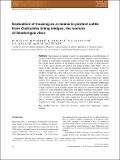| dc.description.abstract | The housing of animals at night was investigated as a possible means of protecting them from attack by Culicoides biting midges (Diptera: Ceratopogonidae), the vectors of bluetongue. Light-trap catches of Culicoides were compared inside and outside animal housing, in the presence and absence of cattle. A three-replicate, 4 x 4 Latin square design was used at four farms in Bala, north Wales, over 12 nights in May and June 2007, and the experiment repeated in October. In the two studies, respectively, >70 000 and >4500 Culicoides were trapped, of which 93% and 86%, respectively, were of the Culicoides obsoletus group. Across the four farms, in May and June, the presence of cattle increased catches of C. obsoletus by 2.3 times, and outside traps caught 6.5 times more insects than inside traps. Similar patterns were apparent in October, but the difference between inside and outside catches was reduced. Catches were strongly correlated with minimum temperature and maximum wind speed and these two variables explained a large amount of night-to-night variation in catch. Outside catches were reduced, to a greater extent than inside catches, by colder minimum temperatures and higher maximum wind speeds. These conditions occur more frequently in October than in May and June, thereby suppressing outside catches more than inside catches, and reducing the apparent degree of exophily of C. obsoletus in autumn. The results suggest that the risk of animals receiving bites from C. obsoletus is reduced by housing at both times of year and the benefit would be greatest on warm, still nights when outside catches are at their greatest. | en_US |

